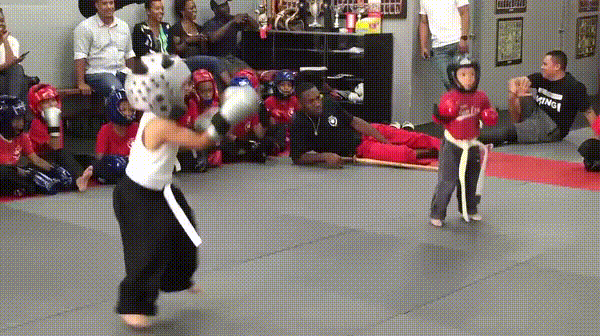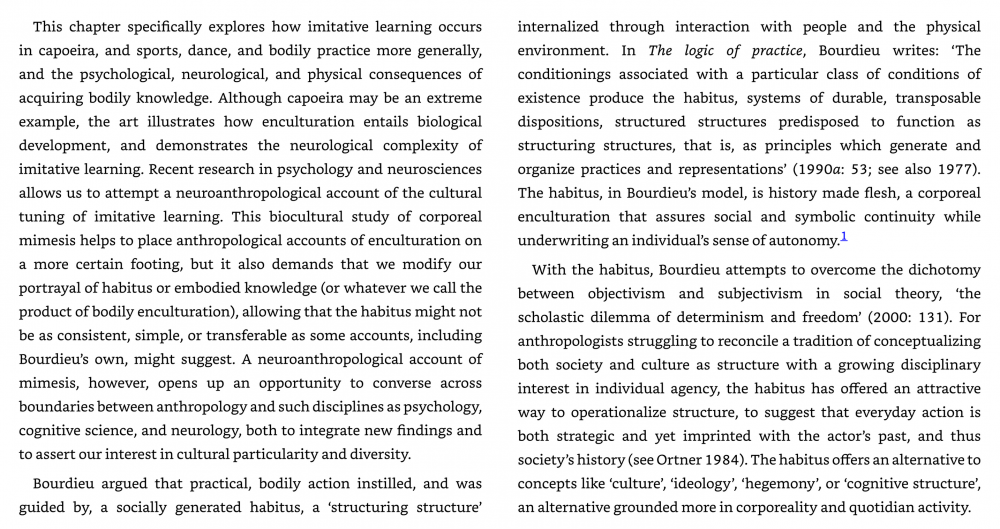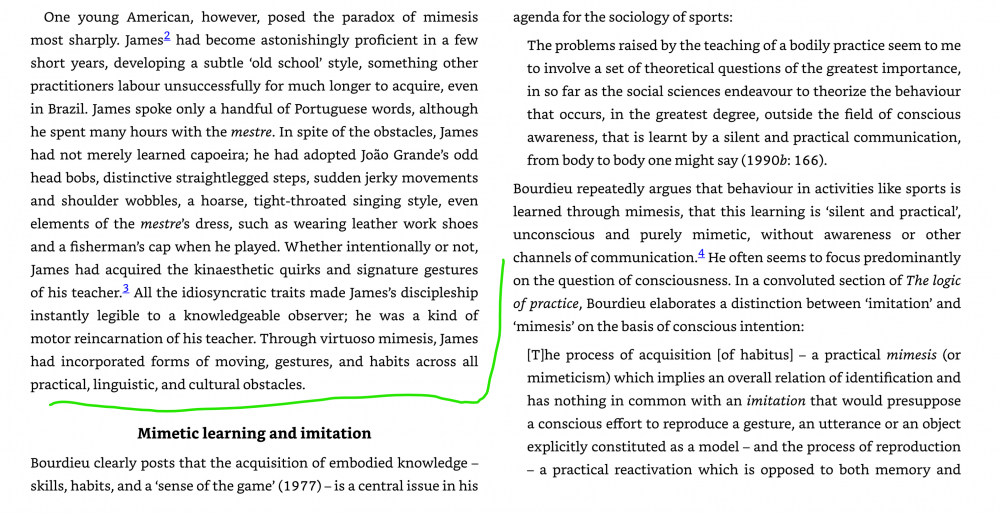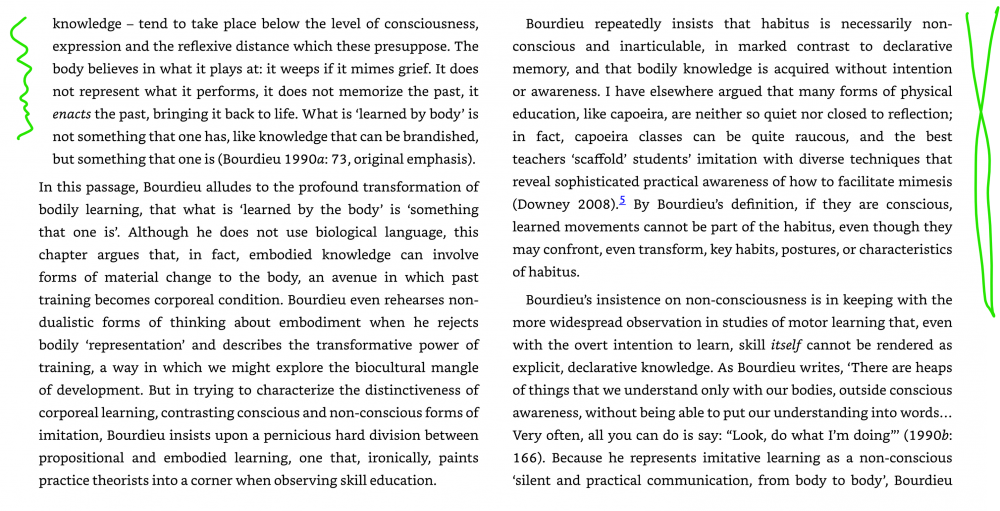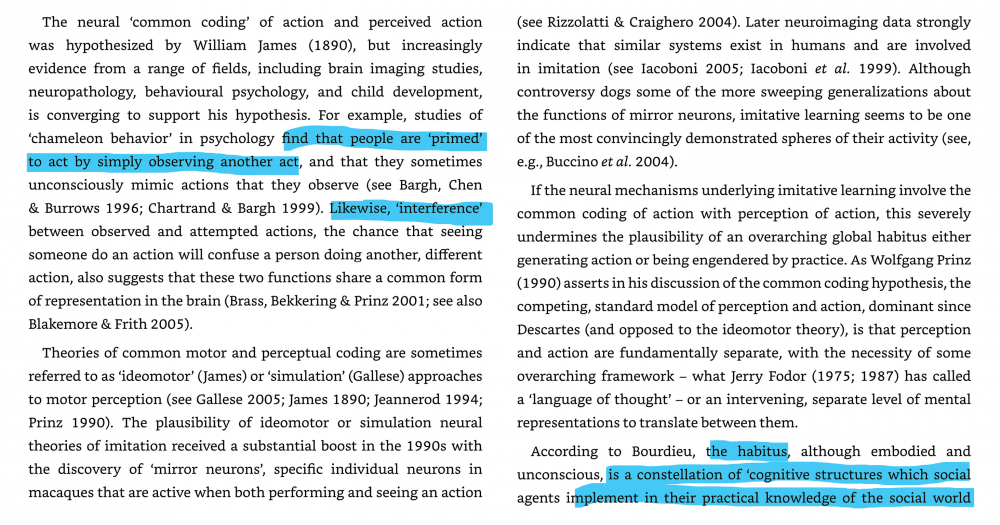Leaderboard
Popular Content
Showing content with the highest reputation on 10/28/2021 in all areas
-
Very interesting article, particularly the delineation between conscious body-learning and unconscious, the clarification between imitation and mimesis specifically. I think it's part of what makes a "natural-born fighter", the ability to not just imitate your teacher but the efficiency of the subconscious to "imitate without question", to perform an action properly without ever consciously having to think about the mechanics behind it. Sometimes thinking about how to perform a move makes you worse at it, I'm sure everyone can relate to being a victim of overthinking. It's often best, as mentioned, to just shut up and do it until it's right. I think the simple roundhouse kick is a great example of this. There are a number of moving parts in a roundhouse: the turning of the shoulder and turning over of the hip, the sweeping of the arms, the pivoting of the feet, etc. There are too many little individual parts to consciously manage in the second or fraction of a second that it takes to throw a proper kick; you just have to do it until it feels right, and when it feels right you'll just know it. And then watching back the video of you throwing it, the difference between the kicks you feel and the ones you don't will be blatantly obvious, at least in my experience. There's also the fact that what feels right for some people doesn't feel right for others. Superbon for example comes up very high on his standing leg when he throws a roundhouse to a degree at which he's basically jumping, yet some people will never throw a roundhouse like that in their entire career and still find great success with it. And still others will watch Superbon and undoubtedly start coming up higher on their standing leg from then on, especially if they're inspired by his recent KO: I personally think things like inspiration and belief of efficacy are subconscious motivators of mimesis, it seems kind of obvious to me. Outside of physical education, I wholly believe that's a factor in general intelligence too; the most intelligent fellows I know just have an unspoken "understanding" of anything they're being educated on, almost like a knack for learning. I believe you can teach pretty much anything to anybody personally, but it's a particular individual's predisposition to mimesis that determines how quickly they'll catch on in my opinion. And child development surely highlights the power of mimesis. Young children cannot particularly "think" at a very high level, as their brains are still developing. It's the subconscious ability of the brain to mime what the child is seeing that allows them to recreate actions that we show them. I mean, do you really think somebody taught this 3 year old how to throw a cartwheel kick by explaining to them the mechanics behind it? I sincerely doubt it. And they definitely didn't teach him how to celebrate his big strike, it's likely he's seen his papa or fighters he watches smash their fists together in victory before. He didn't 'think' about celebrating, he simply did it. Again interesting article, not just from a Muay Thai perspective but in general. Definitely food for thought. I love that many of the nak muay you interview mention learning through watching. It's largely what makes me love muay Thai so much, their style is their personality. It's always interesting to me when one fighter teaches something one way, and another teaches it completely differently but neither of them are wrong. Pipa and Silapathai like to do the monkey teep while Ponsaknoi, from the same gym, says that's stupid just throw it like a normal person haha! Like I mentioned earlier I believe inspiration is a great motivator of mimesis, so to see the tactics each fighter subconsciously chooses to employ is in a way looking at what inspired them to fight in the first place. I think "history made flesh" is an excellent way to describe muay Thai, not in the sense of underwriting individual autonomy but moreso in the enculturation of a fighter. I don't think enculturation and the underwriting of individual autonomy are necessarily exclusive in this case as I believe factors that drive mimesis can definitely come from a place of individuality. The things that inspire us are all different. That's not to say the underwriting of individual autonomy is not also at play in muay Thai; the act of miming someone else is by nature not individually autonomous. Just that it's not exclusive, in my opinion.1 point
-
TANGENT This from Making Knowledge: Explorations of the Indissoluble Relation between Mind, Body and Environment edited by Marchand, the first chapter discussing the embodied knowledge of Capoeira in Brazil, a fighting art that comes closer to dance than most. The emphasis is on the largely instruction-less, mimetic transmission and creation of the knowledge and art. Without the concretizing ballast of thousands of full contact fights as laboratory, Capoeira may bring forward the social creation of a fighting art, having parallels to aspects of Thailand's Muay Thai training (socially created, often mimetic in transmission). Aesthetics and efficacy in tension. If there is one theme when we interviewed legends of the Golden Age and before, it was that nobody actually taught them their style, they created it through social integration in the kaimuay, play (endless sparring, clinch) and by watching. Sirimongkol (FOTY 1972) told us that when he arrived in Bangkok from the provinces he didn't even really know how to fight (a common refrain, but likely a purposeful exaggeration). He learned by his account almost exclusively by watching and imitation, or as Bourdieu would say, mimetic transmission. Continuing on in the essay, making the distinction: In my article The Slow Cook vs The Hack Thailand Development, I discuss the metronome effect in the training in a Thai kaimuay, the way that practices and habits of Muay Thai transmit themselves across the social space, almost unconsciously. The nature of this kind of development is a focus of this cited article, an excerpt a little further along. The tension in the theory, as the author examines the teaching and training of Capoeira (which appears in some ways quite different than that of traditional Muay Thai, which is not master-centric, despite sharing non-verbal components), is between just how much skill development is is conscious or unconscious. Bourdieu's concept of an unconscious habitus which acts as the generative grammar of a space point to hidden aspects of kaimuay training, such a socially correct hierarchies or gendered expectations, which underwrite the more fulsome aspects of technique and skill acquisition in Thailand's Muay Thai. The generative habitus, likened to the painters style, a person's handwriting, a way of being of a class of people, helps explain the transmission of aspects of an art not contained in physical technical imitation: Capoeira's malicia is compared to Bourdieu's habitus, an all pervading vision of the subject and the world, positioning and conditioning the art. This is not too different than the acquisition of embodied principles of Muay Thai in the kaimuay, aspects such as auton, ning, ruup, haut, various rhythms and dispositions that communicate the ethos of the art, and even more particularly the ethos of a gym:1 point
-
Sylvie said she thought he was maybe 18-20? We really don't know the legal structure of prosecution of cases like these, but because jail is a possibility it does read as a criminal matter. Usually if I understand it, aside from legal (jail/fine) issues, a fighter is often banned from the entire BKK stadia circuit.1 point
Footer title
This content can be configured within your theme settings in your ACP. You can add any HTML including images, paragraphs and lists.
Footer title
This content can be configured within your theme settings in your ACP. You can add any HTML including images, paragraphs and lists.
Footer title
This content can be configured within your theme settings in your ACP. You can add any HTML including images, paragraphs and lists.

